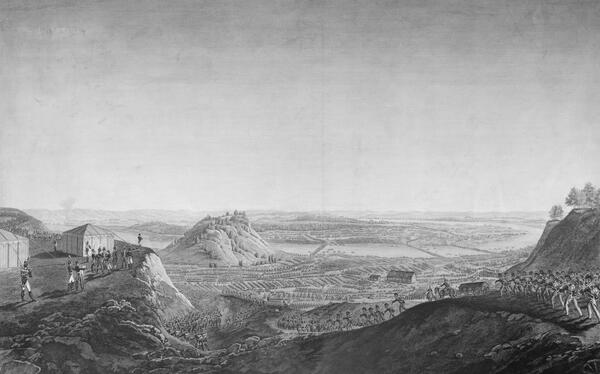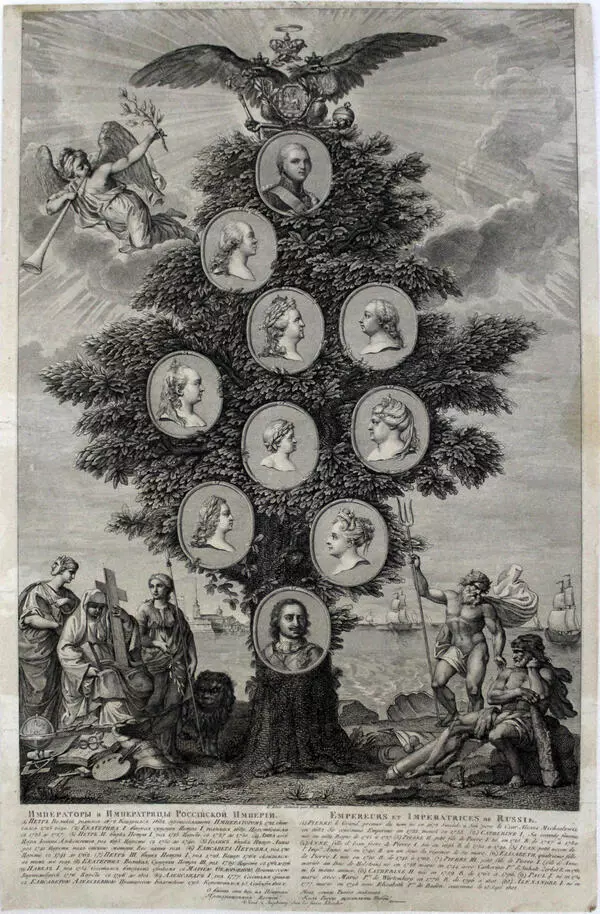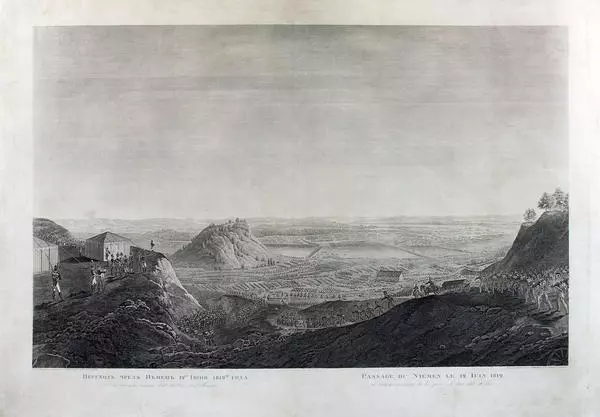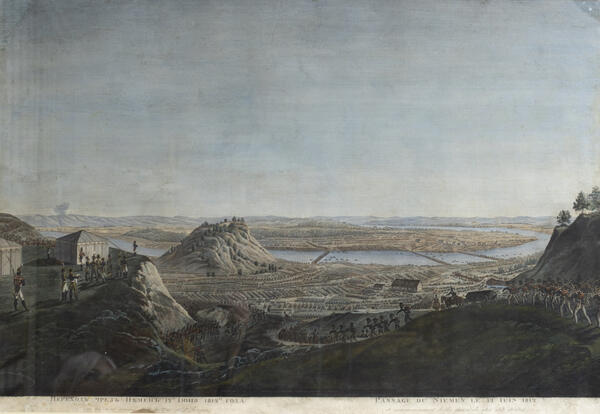The engraving Crossing the Neman on 12 June 1812 was created by German engraver Ignaz Sebastian Clauber after 1814. Its plot is based on an important historical event: the beginning of the war, when Napoleon’s troops began crossing the Neman River. The artwork was made after a sketch by Giuseppe Pietro Bagetti Napoleon’s Grand Armee Crossing the Neman on June 12 [24], 1812. The engraving depicts a magnificent invasion and the lonely figure of the Emperor standing on a rock. With his arms folded over his chest, he is watching the troops move to the other side, in a crossing consisting of three powerful military streams.
To attack Russia, Napoleon had to assemble a powerful army, really huge for its time. Only the first echelon, which was assigned to the borders of the Russian Empire, consisted of 450 thousand brave warriors. Two other army corps stayed in reserve. In total, the powerful army consisted of more than 600 thousand soldiers.
The Russian Empire expected war to break out. Napoleon’s attack was to occur in the spring of 1812. Given this fact, Emperor Alexander I resided in Vilna since the end of April in order to timely respond to the upcoming invasion.
The Russian troops were divided into two echelons. The first was 250 thousand people (3 field armies) strong. The second echelon totaled at least 65 thousand people.
Napoleon hoped to destroy the Russian troops during the battles on the border territories, after which he wanted to persuade the Russian empire to reach a settlement on the terms set forth by him.
On June 12 (24), in Kovno, Napoleonic troops began crossing the border, the Neman River. Cossack border patrols noticed the movement and informed the Russian command of what was happening. This turned out to be very timely, since official information from St. Petersburg about the start of the war had not yet been delivered.
For almost a week, troops of the first echelon of the Grand Armee were moved along the border. One corps was headed by Napoleon himself. After the successful crossing of the Neman (for this purpose, three temporary bridges were used), the army went to Vilna. It was followed suit by the representatives of the factions of Jerome Bonaparte and Prince Eugene de Beauharnais.
On the first day of the crossing, Napoleon was on the left bank of the Neman and watched his troops through the spyglass. The human lava was pouring incessantly out of the Vilkavisi forest. The warriors knew that the Commander-in-Chief was watching them, so they tried to catch sight of him. As soon as the soldiers noticed the figure on the hill, wearing a hat and a frock coat, they threw up their hats and shouted: “Vive l”Empereur! ”
With his engraving, Ignaz Sebastian Klauber tried to convey the grandeur and importance of the moment, to portray the so-called “Rubicon transition”. Many eyewitnesses of this event captured it in their memoirs and notes.
To attack Russia, Napoleon had to assemble a powerful army, really huge for its time. Only the first echelon, which was assigned to the borders of the Russian Empire, consisted of 450 thousand brave warriors. Two other army corps stayed in reserve. In total, the powerful army consisted of more than 600 thousand soldiers.
The Russian Empire expected war to break out. Napoleon’s attack was to occur in the spring of 1812. Given this fact, Emperor Alexander I resided in Vilna since the end of April in order to timely respond to the upcoming invasion.
The Russian troops were divided into two echelons. The first was 250 thousand people (3 field armies) strong. The second echelon totaled at least 65 thousand people.
Napoleon hoped to destroy the Russian troops during the battles on the border territories, after which he wanted to persuade the Russian empire to reach a settlement on the terms set forth by him.
On June 12 (24), in Kovno, Napoleonic troops began crossing the border, the Neman River. Cossack border patrols noticed the movement and informed the Russian command of what was happening. This turned out to be very timely, since official information from St. Petersburg about the start of the war had not yet been delivered.
For almost a week, troops of the first echelon of the Grand Armee were moved along the border. One corps was headed by Napoleon himself. After the successful crossing of the Neman (for this purpose, three temporary bridges were used), the army went to Vilna. It was followed suit by the representatives of the factions of Jerome Bonaparte and Prince Eugene de Beauharnais.
On the first day of the crossing, Napoleon was on the left bank of the Neman and watched his troops through the spyglass. The human lava was pouring incessantly out of the Vilkavisi forest. The warriors knew that the Commander-in-Chief was watching them, so they tried to catch sight of him. As soon as the soldiers noticed the figure on the hill, wearing a hat and a frock coat, they threw up their hats and shouted: “Vive l”Empereur! ”
With his engraving, Ignaz Sebastian Klauber tried to convey the grandeur and importance of the moment, to portray the so-called “Rubicon transition”. Many eyewitnesses of this event captured it in their memoirs and notes.







